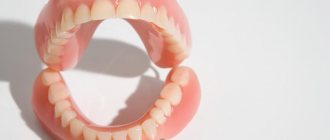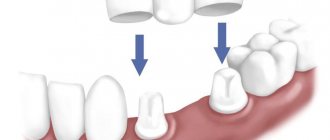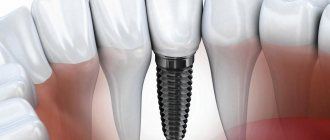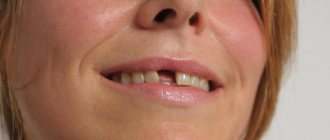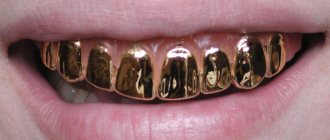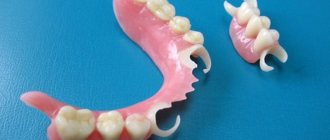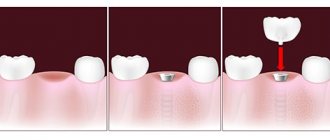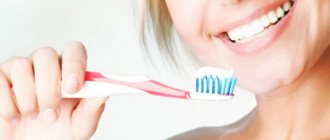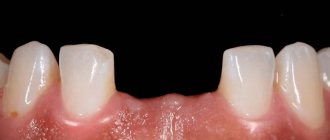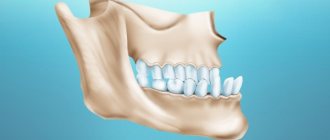Why are fixed dental prostheses needed, and which ones to choose - an overview of all possible options
Article navigation
- Product Information
- Varieties
- - crowns and bridges
- - dentures on implants
- - veneers and lumineers
- — stump inlays
- Limitations to prosthetics
- If all teeth are missing
- Materials
- How to make
- How long will they last?
- Habituation and care
- Price
question to a specialist
In the modern world, the problem of dental prosthetics is quite acute, because your “native” teeth grow only 2 times in a lifetime and over time begin to collapse from injuries and caries, which affects 90% of the population. Now dentistry offers many solutions to this problem, and one of the most reliable is fixed dentures. Next, we will talk about what they are, in what cases they are suitable, and what their cost is.
What types of fixed prosthetics and when are they used?
In modern dentistry, there are the following technologies of fixed prosthetics:
- Microprosthetics
:
- installation of veneers/lumineers – used primarily for aesthetic reasons to correct chipped enamel, small defects in the front wall of the tooth, eliminate gaps, irreversible changes in enamel color, etc.
- Prosthetics with ceramic inlays help to reliably restore even a badly damaged tooth with a large cavity.
- Prosthetics using a crown
. This type of permanent prosthetics is used to restore a single tooth crown, even after its complete destruction, provided that the tooth root is preserved. - metal-ceramic
- metal-free
- zirconium.
. This type of fixed prosthetics is used when it is necessary to restore 1-2 lost teeth in the presence of neighboring ones and is often recommended as temporary.
Dentures on implants are indicated in the absence of a large number of teeth.
- Single implantation is the most reliable and aesthetic way to restore a tooth lost by the roots.
- Prosthetics of one jaw on 4, 6 implants
Prosthetics of the jaw or part of it on implants is the most modern, natural and reliable method of restoring dentition.
Video: interview with the head physician and orthopedist of the clinic R.Z. Babaev
Watch a video about how the entire process of high-quality dental restoration takes place - from the first visit, planning and to the implementation of the plan into a real smile. Watch an interview with Roman Zakirovich’s patient, Svetlana, and find out the main principle of a good doctor’s work.
Brief information about products
What is a fixed denture? In general, prosthetics is the restoration of part of a tooth or a missing tooth along with the root. And many doctors even classify fillings as permanent prosthetics, which confuses patients. Therefore, we will call non-removable dentures such orthopedic structures that restore the integrity of teeth or make up for their presence, and they are also fixedly fixed on supporting teeth or implants. Moreover, such dentures were produced in a dental laboratory or at a specialized enterprise.
To understand the difference between a removable denture and a fixed one, let’s remember the well-known false jaws - they can be easily removed and installed back by the person himself. Therefore they are removable. And a person cannot remove non-removable structures even if they want to, especially since there is no need for this.
Indications and contraindications
Modern prosthetics can completely restore the dentition for any problem:
- the absence of several teeth in a row on one side;
- if there are single holes in the dentition;
- teeth are completely missing;
- patient's reluctance to wear removable dentures.
The prosthetic procedure is postponed if:
- the oral cavity is not sanitized;
- an inflammatory process of the gums or teeth is detected;
- bone tissue damage was detected.
Sometimes a patient is denied permanent prosthetics if:
- mental illness or age-related disorders;
- allergic reaction materials used;
- anesthesia cannot be administered;
- there are colds or pulmonary pathologies in the acute stages;
- oncology;
- diabetes;
- clotting is impaired;
- advanced age of the patient.
Types of fixed structures
The classification of fixed dentures includes several areas - it may take into account what materials are used for manufacturing, how the product is made, what size it is, and how it is attached (on teeth or on implants). Let us next consider the most popular types of fixed dentures.
Crowns and bridges on your own teeth
An artificial crown is a miniature non-removable dental prosthesis (similar to a cap), exactly repeating the shape and size of a natural dental crown. They put a crown on the stump (the ground top of the tooth), since if the tooth is destroyed by more than half, then a filling or microprosthesis cannot be placed. A bridge is several crowns connected together. Moreover, the outermost ones will be installed on the teeth adjacent to the defect, and the central ones will fill in the missing ones (but only their tops, not the roots).
Indications for installing a crown are that part of the tooth or its root has been preserved, under which there is no inflammation or cysts. Indications for installing a bridge are missing 1-3 teeth in a row, and at the edges of such a defect there must be at least one healthy root.
Dentures on implants
The already discussed crowns and bridges can be installed on implants (only instead of “living” supports, dental implants are used here). Extended dentures are also widely used - they contain not only crowns, but also a gum acrylic base (this is if all the teeth are missing), a metal or fiberglass frame, and fastening elements to implants.
EXPERT OPINION Bespalov Roman Dmitrievich
“Fixed dentures on implants are considered the best option in the absence of any number of teeth, of course, along with the roots. The fact is that this is not only a firmly fixed restoration, but also a physiological one, because During implantation, the missing root is replaced. That is, the bone substance of the jaw will receive chewing load from the implant, as it previously received from the root. Therefore, the bone does not sag and the gingival level does not decrease – as happens under traditional bridges and removable dentures.”
Microprostheses – veneers and lumineers, restorative inlays
Microprostheses are miniature structures that replace only part of the crown. Installed provided that more than 50% of it is preserved. Veneers and lumineers are the thinnest plates that are placed only on the front teeth. Moreover, they not only greatly enhance the beauty of a smile, but are also very strong and durable (especially lumineers from Cerinate and E.max veneers made of zirconium dioxide from Ivoclar Vivadent). And a restorative inlay is, in fact, a very strong filling, made by a high-precision laboratory method and subsequently installed on the chewing teeth.
Stump inlays
Stump inlays are not full-fledged prostheses, but a support for them (under artificial crowns, bridges, etc.). They are placed with the lower part into the root canals, and the prosthesis is placed on the upper part. They greatly increase the strength and durability of the entire structure, unlike conventional pins. Indications – almost complete destruction of the tooth apex, provided that the root is intact (without cracks and root inflammation).
Why do you need dental prosthetics?
- With the complete loss or severe destruction of one or more teeth, deformation of the WHOLE dentition occurs - neighboring teeth shift towards the gap, tilt, there is a loss of physiological interdental contacts and, as a result, a disruption of the bite and the functioning of the entire dental system. So dental prosthetics is not only desirable, it is necessary, regardless of aesthetic ones - purely for medical reasons.
- Aesthetic indications for the installation of, for example, veneers are a separate issue, and here, of course, the patient’s desire plays the main role.
Advantages
The main advantage of fixed prosthetics is a complete solution to the patient’s problem – “set it and forget it.”
What are the limitations to this type of prosthetics?
Contraindications to various types of fixed structures can be relative and absolute. Relative (they can be overcome over time) - unsatisfactory condition of the oral cavity (caries, pulpitis, stomatitis, gingivitis), general diseases of the body in the acute stage. Absolute – shaky teeth that are planned to be used as supports, osteoporosis, decaying roots, periodontitis.
But these absolute prohibitions are relevant only for classic non-removable ones, and not for implants. After all, modern implants can be implanted when there is a lack of bone, when its structure is “loose,” or when there is inflammation. True, implantation also has contraindications - pregnancy, childhood, intolerance to anesthesia, the presence of dangerous pathologies that weaken the body (for example, decompensated diabetes mellitus, oncology).
Advantages
Fixed-mount prostheses have the following features:
- complete restoration of speech and chewing functions;
- fixed dentures do not cause disturbances in diction, the sense of taste does not change;
- the patient does not experience pain or discomfort (if necessary, local anesthesia is given during installation);
- when worn, the patient has no feeling of a foreign object in the mouth;
- Hypoallergenic materials are used for the manufacture of prostheses.
The only disadvantage of prosthetics is the rather high price compared to conventional removable structures. But this is justified by the comfort of wearing, the absence of negative sensations and pain. The functionality of the jaws and facial contours are completely restored; the installation of permanent dentures eliminates the risk of bone atrophy.
How to properly care
Fixed dental prostheses have a long service life - from 7-10 years or more, which depends on the type of design and materials used for manufacturing. The service life and condition of dentures are influenced not only by the quality of materials, but also by the patient’s compliance with oral care rules:
- Every six months it is recommended to visit a doctor for a preventive examination and control of the condition of the prostheses;
- You should brush your teeth twice a day, using special pastes, brushes with soft and medium bristles, and mouth rinses after meals;
- At least once a year it is necessary to carry out professional cleaning of stone and plaque.
Prices
The average price for fixed dentures is 27-45 thousand rubles. But we must take into account that the full cost is not only the manufacture of the structure, but also the following expenses:
- type of design chosen and materials of manufacture;
- fixation methods;
- the patient's oral health;
- the need for additional diagnostic studies;
- carried out preliminary treatment, elimination of destroyed units and inflammatory processes;
- number of units restored.
The Two Dentists clinic offers prosthetics using fixed structures at affordable prices. These are new generation designs installed in a fully equipped office. For more information, to make an appointment with a doctor for an examination or consultation, call us at +7 (812) 438-21-17.
Fixed dentures if all teeth are missing
The problem of complete absence of teeth is now solved quite simply and efficiently - from 3 to 12-14 implants are installed on one jaw (depending on the indications), and a full-fledged fixed prosthesis is fixed on them. Moreover, it is much lighter and more convenient than a regular removable one that “sticks” to the gums - it does not move or fall out while chewing food, does not rub the gums and does not cause nausea. Modern protocols make it possible to carry out such implantation with subsequent prosthetics in just 3-5 days. The service life of such a structure starts from 15 years - which is 2-3 times longer than that of a removable one.
Materials from which prostheses are made
The following materials are used in our clinic:
- metals - most often cobalt, nickel or chrome alloys, as well as noble metals;
- metal ceramics - the frame here is also metal, but ceramic cladding is applied on top, which allows you to create the proper aesthetic appearance. Such dentures are suitable for chewing teeth, as they have high strength;
- glass ceramics – lithium disilicate. The peculiarity of the material is its strength and aesthetic appearance. Most often, dentures made from this material are chosen for the front teeth, since they are most similar to natural enamel;
- zirconium dioxide - it is characterized by excellent aesthetic qualities and a long service life.
A modern material for the manufacture of prostheses is ceramic composite. It consists of a mixture of ceramics and polymers, is lightweight and durable, and with impressive durability is not too expensive.
How are permanent structures made?
For production, they use the capacity of a dental laboratory (located at a dental clinic or a third-party organization), and, for example, lumineers are manufactured in only one laboratory in the USA. Metal and plastic are processed by casting, ceramics are pressed onto crowns or workpieces are lined with it. The most modern production method, and it is also the most accurate, is production using CAD/CAM systems. Here, a computer model of the prosthesis is first created, which is then milled on a robotic machine.
How are fixed dentures installed?
The first and most important stage is a comprehensive diagnosis, which can be performed already at the first consultation, thereby saving time on visits to the doctor. Most often, an objective examination of the oral cavity is performed and an x-ray examination is prescribed. The most informative method is computed tomography (CT). Based on the results obtained, the doctor assesses the risks and prospects of treatment, discusses with the patient, and draws up a treatment plan.
The next step is to take impressions of the jaws and create plaster or virtual models of the jaws. To do this, the orthopedist takes impressions and sends them to the laboratory.
There, wax models of the finished teeth are made and sent to the doctor.
At the next appointment , the specialist transfers the wax model into the oral cavity using special plastic. The patient can see the shape of future teeth and evaluate it. If everything is satisfactory, then on the same day the teeth are prepared and their surfaces are prepared for fixing temporary plastic crowns.
The final stage is fixation of the finished structures in the oral cavity. Crowns are secured with special dental materials with increased strength to ensure unlimited wearing of fixed dentures.
In the future, dynamic monitoring and regular visits to the dentist are required to monitor the wear of the crowns. At Dr. Lemberg's Dental Clinic, specialists offer a range of procedures to maintain a healthy smile after dentures. Thanks to this, the functioning of the prostheses improves and the guaranteed period of wearing them is extended.
How long will dentures last?
The service life of fixed dentures depends on the type of design, manufacturing technology and professionalism of the dental technician, as well as on how carefully the patient adheres to the care rules. For example, crowns and bridges supported by your own teeth will last 5-7 years, and similar structures on implants will last about 15 years (and zirconium and ceramic composite ones will last at least 25 years). Moreover, the implants themselves do not need to be changed when replacing the prosthesis.
The service life of ceramic veneers and inlays starts at 10 years, and zirconium dioxide microprostheses will last about 25 years. Lumineers have the same service life.
Types of crowns for implants
The final stage of prosthetics is installing a crown on the implant . Only after this your dentition is completely restored and has an appearance indistinguishable from the original one. Modern technologies make it possible to make crowns from various materials, but only 2 are suitable for implantation - metal ceramics and zirconium dioxide.
Of course, this applies to permanent crowns. But there are also temporary ones - those that protect the gums during the healing of the implant and prevent neighboring teeth from “converging”. They are also important for the aesthetics of the dentition. Temporary structures come in different types, and the price depends on the material used. how much a temporary crown for an implant costs when choosing the best option.
A temporary crown can be:
- made of plastic - a proven option that requires some time to manufacture and caution with the use of coloring products;
- made of acrylic - is made faster and is more resistant to staining and plaque formation.
The cost of a crown for an implant is, of course, an important factor, but it should not be decisive when choosing. For anterior teeth, aesthetics are still decisive. For chewers – resistance to stress. The fact is that the use of temporary crowns can last from 4 months to six months, so performance characteristics that ensure comfort are more important.
The price of permanent crown on an implant in Moscow can vary significantly in different clinics. However, direct connections with manufacturers allow us to offer patients the most comfortable conditions.
How difficult is it to get used to and care for dentures?
How to get used to fixed dentures? Getting used to it usually does not cause much discomfort - a person may not even notice that there is a foreign body in the mouth. But if teeth have been missing for a long time, then after dentures it may not be customary to eat and talk with new artificial teeth. Therefore, you need to do gymnastics “for the mouth” - read poetry or tongue twisters.
How to clean fixed dentures? To clean, you will need a brush with soft or medium-hard bristles, as well as toothpaste without scratching particles. After each meal, you should rinse your mouth with clean water to prevent bacteria and plaque from accumulating on your food. Dentists do not recommend using restorations for purposes other than their intended purpose - cracking nut shells, opening lids with your mouth, etc. As for veneers, it is better not to bite off a large piece of food with them, but to cut it first.
Read on the topic: a complete set of simple rules for caring for new teeth.
Why do you have to resort to prosthetics?
Preserving teeth, unfortunately, is not always possible. Poor environment, lack of proper nutrition, and insufficient care lead to the development of caries, and sometimes to more serious problems and complications, for example, pulpitis, cyst development, or periodontitis. Non-viable teeth and damaged roots have to be removed, which creates gaps that impair the functionality and appearance of the dentition. Fixed dentures help restore aesthetics and completely take over the functions of lost teeth.
Removable dentures bring patients a lot of unpleasant moments associated with the need to take them out and clean them. The main feature that distinguishes fixed dentures is their long service life, during which the structures remain in the patient’s mouth constantly, completely naturally replacing lost teeth. The patient cannot remove such dentures on his own; they feel almost the same as the native dentition.
Fixed dentures can be temporary or permanent. The first ones are installed for the period while the permanent system is being manufactured. To make temporary ones, plastic reinforced with fiberglass is used. The maximum service life of such a prosthesis does not exceed one and a half years.
Cost of fixed structures
How much does it cost to install a fixed denture? The price varies depending on the material, the length of the structure, the method of manufacture and installation (since when prosthetics on implants, the price includes their price and the salary of the implant dentist). For example, a metal-ceramic crown on a “native” tooth can cost 10-15 thousand rubles, and together with an implant – about 30 thousand.
How much does a fixed denture cost for both jaws? If there are healthy roots that are suitable for supports, then to calculate the cost of the bridge, you need to multiply the price of 1 crown by their number. When teeth are no longer there or they need to be removed, the only option to install permanent orthopedic structures right away is to carry out a one-stage implantation with immediate prosthetics. The cost of such solutions starts from 180 thousand rubles for 1 jaw.
Fixed dentures
Modern dentists use modern techniques and reliable materials to avoid the extreme measure of tooth extraction. However, there are situations when it is impossible to save a dental unit. Unfortunately, the cause of tooth loss can be psychological problems associated with the patient’s fear of doctors. Often teeth are lost as a result of attempts to save money on treatment, when the patient goes to a dubious clinic and receives the wrong treatment.
However, in most cases, tooth extraction is still associated with other reasons:
- poor oral hygiene, including poor cleaning and lack of dental supervision;
- late seeking dental care;
- chronic diseases that make dental treatment ineffective;
- genetic anomalies and deviations leading to rapid tooth decay;
- taking medications that cause tooth decay;
- jaw injuries.
After removal of the tooth and treatment, it is necessary to install a prosthesis, preferably within a month. This is necessary so that the jaw receives the correct load, and the bone tissue does not lose its healthy volume. One of the options to solve the problem is fixed prosthetics.
